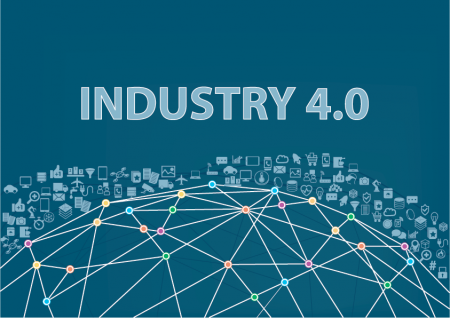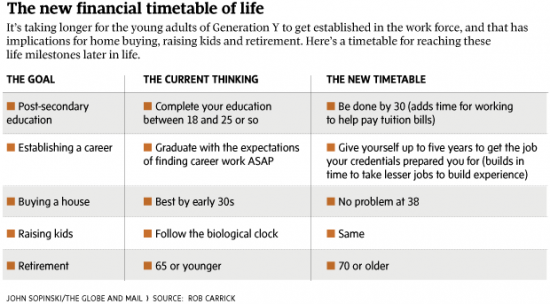April 6, 2016 – Young people today have altered expectations about career and future today. In a Globe and Mail article entitled, “How GenY can have it all – careers, houses and retirement,” author Rob Carrick, describes how the “timetable of life” has altered at the beginning of the 4th Industrial Revolution. He produces a chart showing the difference between the expectation of “Gen Xers” versus “Gen Ys” youth.
If unfamiliar with the terms, Gen Xers refers to the generation born after the post-World War II baby boom. Their birth dates range from the 1960s to the early 1980s. Gen Ys, also known as millennials were born after 1980 reaching adulthood in the year 2000 or later. The late Gen Xers and some early Gen Ys represent “The Current Thinking” seen in the chart above. Late Gen Ys will experience “The New Timetable.” So if you were born in 1991 you can expect to follow the latter rather than the former.
What made me look more closely at this table is the first two lines, “post-secondary education” and “establishing a career.” Whereas those born from the mid-1960s to 1980s had expectations that education would immediately lead to career upon graduation, those born after find themselves extending education and even then experiencing career uncertainty upon entering the job market.
In a quote from the chairperson of Infosys Foundation USA, Vandana Sikka she states, “Young students need to understand that education alone should not be expected to fully prepare them for a job, because the skills they need to be successful in their work will continually change as industries transform. Their success, therefore, will depend on their ability to learn and they must have a mindset of learning for life.”
What role should companies play in ensuring that young people can have career aspirations while constantly learning to adapt to the disruptive changes brought on by the 4th Industrial Revolution? When I graduated from university in 1973 the company I went to work for provided a week-long training program to help me understand the work involved. How many companies still provide that kind of training investment in new employees?
Somehow from the 1980s onward companies stopped playing a significant role in educating their new work forces and transferred that responsibility to post-secondary education providers. The burden of applied learning became not just a community college deliverable, but also one that universities were asked to provide.
Who is better at predicting what skill sets a business needs now and in the future? One would argue that the leadership within the business would provide the vision for future required skills. Sikka in a YouTube video talks about the millions of jobs that will arise in the next five years requiring skills we may not have anticipated.
For colleges and universities to educate students they must use broad brush strokes and one wonders how often they will guess right when they attempt to drill down on future job requirements. So as much as educators can approach the 4th Industrial Revolution with curriculum focused on complex problem solving, critical thinking and creativity, although these are flexible skill sets, they cannot provide a high level of specificity. Their work is to give learners adaptability advantages which employers can then build upon with additional training.
One aspect of the 4th Industrial Revolution we are already observing is that lifelong learners are not necessarily workers dedicated to a single employer. The reality of the age is adaptive learners can and may work for multiple companies in a lifetime, let alone every day. The future workplace may be dominated by freelancers.
Some businesses get it and incorporate the adaptive learning style into corporate culture. One of those is Alphabet, the renamed Google. The company has demonstrated from its founding that it understands what adaptive learning means in its workforce. It is the idea behind 20% self-time, a Google creation that has paid many dividends. Still practised but not as much as it was when the company first got started, 20% self-time gives an employee the the opportunity to spend 20% of each week working on anything he or she finds appealing. This freedom to explore and build new things benefits the company as new ideas percolate, are shared and critiqued, further massaged and perfected, and sometimes turned into products benefiting both the inventor and the company. That’s how Gmail and Autocomplete came to be.
Alphabet’s corporate leaders know they have a responsibility to marry prospective employees exposed to 4th Industrial Revolution education with the company mission and vision. The critical skills described in Part Two of this series are what the company is exploiting in its workplace And as artificial intelligence becomes more pervasive, it is these adaptive learning skills that exploit human creativity and critical problem solving combined with interpersonal rapport, that will be the high demand soft skills of the 21st century.
A final note, remember the goals first described in the chart that appears at the top of this article? The bottom three are not attainable without success in the first two. An educational system embraced by both academic institutions and employers will be necessary to give Gen Y learners in the 4th Industrial Revolution the ability to raise a family, buy a home and fulfill all their other dreams here in the 21st century.













